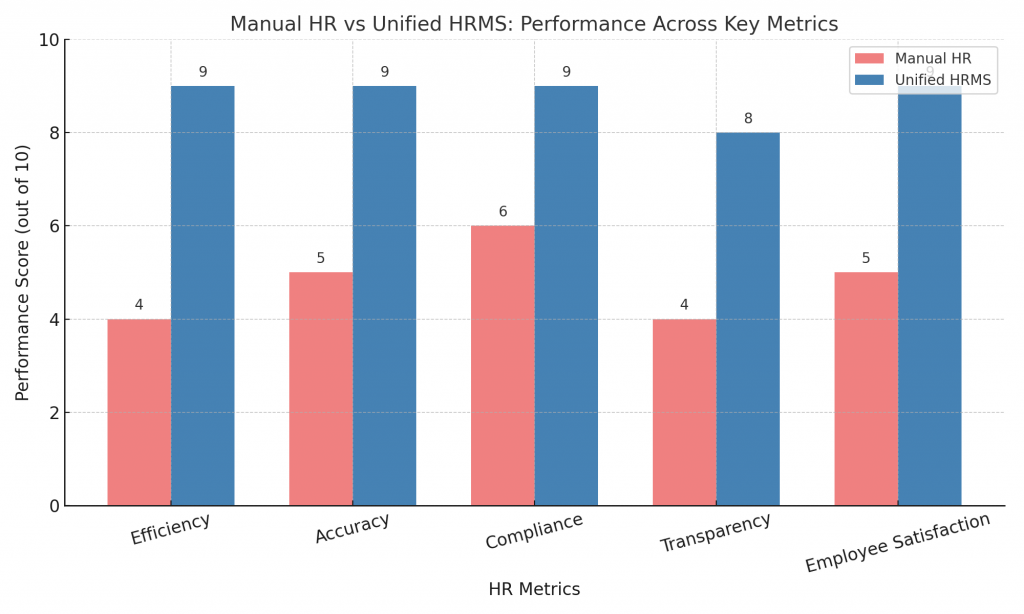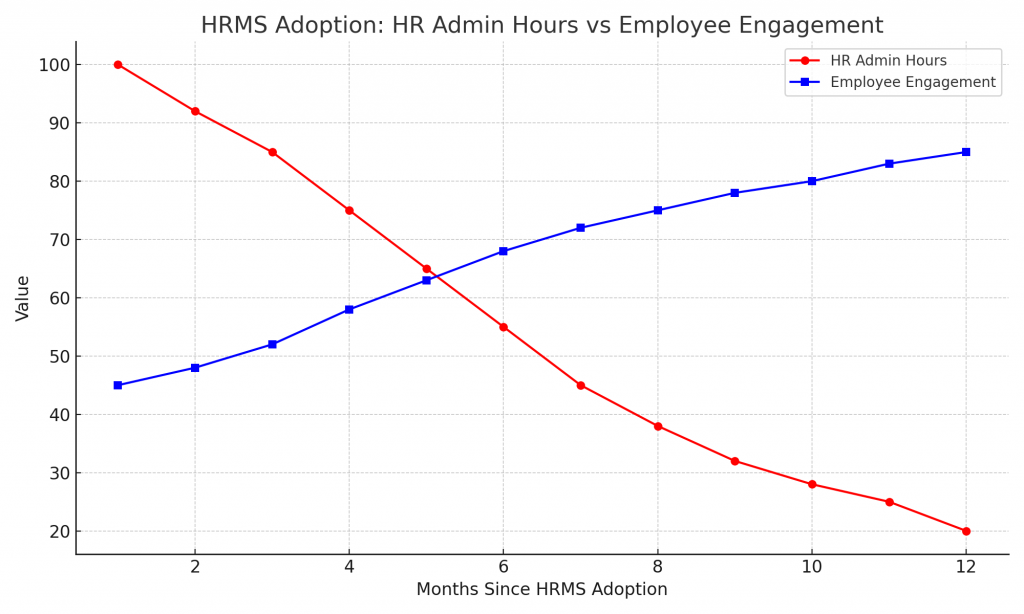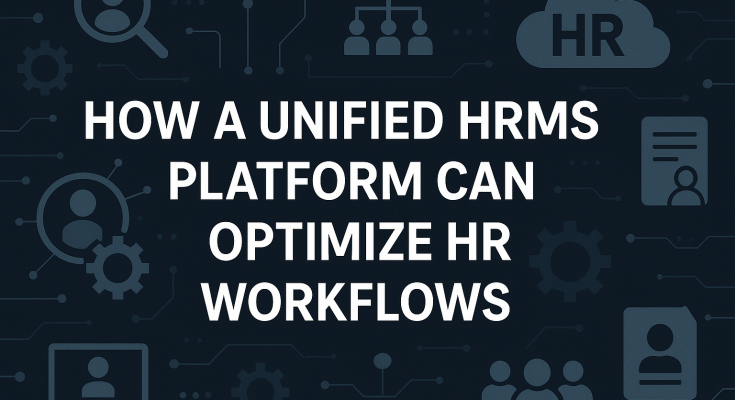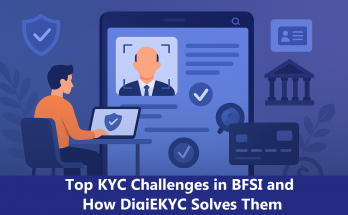Workforce dynamics have undergone a major transformation in recent years. Remote and hybrid work have become the norm, bringing with them increased expectations for flexibility and digital access. At the same time, growing regulatory complexity and outdated HR tech added pressure on HR teams. According to a 2025 Gartner report, 55% of HR leaders say their existing HR technologies no longer align with the needs of a modern business.
Legacy HR platforms often lead to repeated work, misaligned processes, and unreliable data for decision-making. As the demand for integrated, agile operations grows, organisations must rethink their approach to workforce management. A unified human resource management system (HRMS) provides a scalable, digital foundation by automating routine tasks, consolidating data, and enabling HR to focus on strategic priorities such as culture, performance, and organisational growth.
This blog explores how businesses of all sizes and industries can benefit from a unified HRMS for people management. We will discuss why an integrated HR management solution is essential for success in today’s digital tech-assisted business environment.
What is a Unified HRMS Platform?
A unified HRMS platform is a comprehensive, all-in-one digital solution that consolidates and automates the entire spectrum of HR functions through a single, user-friendly interface. Instead of depending on fragmented systems for handling individual HR functions, a unified HRMS brings everything from recruitment, onboarding, attendance tracking, leave management, performance reviews, and exit formalities into one cohesive ecosystem.
Anand Rathi IT’s E-HR stands as a distinguished example of such a unified HRMS solution. Designed to address modern workforce needs, E-HR eliminates the inefficiencies of legacy HR systems that often involve manual workflows and siloed data. This unified HR management platform enhances visibility, reduces administrative strain, and transitions businesses from outdated methods to streamlined, data-driven HR operations.
Legacy HR System vs. Unified HRMS Platform
Legacy HRMS systems, once considered the industry standard, were typically built around fragmented, single-point solutions, each handling a specific HR function such as attendance tracking, leave management, or performance evaluation. While each tool fulfilled its individual purpose, the absence of integration meant HR teams had to manually consolidate data, often leading to delays and inconsistencies.
In contrast, a modern unified HRMS platform like E-HR offers a fully integrated environment where all core HR functions are interlinked and accessible from a centralised dashboard. With workflow automation in place, the system provides live data updates and actionable analytics, enabling error-free HR processes, precise decision-making, and enhanced organisational productivity.
To illustrate clear distinctions between the Legacy HRMS platform and Unified HRMS, the table below compares the core features of traditional legacy HRMS systems with those of modern unified HRMS platforms:
Challenges Businesses Face Without a Unified HRMS
Organisations that operate without a unified HRMS often face fragmented systems, where core functions like attendance, payroll, and employee records are managed separately. The siloed approach leads to repetitive data entry, increased error rates, and a significant administrative burden on HR teams. It often consumes up to 40% of HR leaders’ time on routine tasks. The result is reduced efficiency and limited capacity for strategic HR initiatives.
Employees also deal with inefficiencies in legacy HR systems, such as inconsistent policy visibility and limited access to payroll and healthcare benefits. These gaps contribute to frustration and reduced engagement. Moreover, without centralised analytics, organisations struggle to monitor key trends such as attrition or absenteeism. Compliance becomes another risk area, as manual tracking of regulatory updates can lead to oversights and potential penalties.
The diagram below offers a quick comparison of how traditional HR practices stack up against a modern Unified HRMS platform across five critical dimensions—Efficiency, Accuracy, Compliance, Transparency, and Employee Satisfaction:

How Unified HRMS Transforms Outdated Manual HR Practices
As organisations continue to evolve in scale and structure, the demand for integrated digital systems to manage people processes is accelerating. With global enterprise software spending projected to surpass $1.1 trillion by 2025, it’s evident that businesses are prioritising intelligent, centralised platforms. Unified HRMS systems are a natural extension of this shift.
Outlined below are the benefits a unified HRMS platform can bring to your business:
1. Converging with the Digital Core of Modern Enterprises
Modern HRMS platforms automate repetitive processes such as attendance tracking, leave approvals, and payroll calculations, minimising human error and administrative delays. System-generated notifications and policy updates ensure compliance and timely action without manual follow-ups.
2. Empowering a Self-Reliant and Transparent Workforce
With self-service access via web and mobile interfaces, employees can view policies, track leave balances, and manage their documents independently. This transparency enhances trust and fosters a more engaged workforce, particularly critical in hybrid and remote work environments.
3. Redefining HR’s Strategic Role in Business Growth
By reducing time spent on administrative activities, HR teams can focus on high-value initiatives such as people development and strategic workforce planning. This shift is increasingly important, as 67% of enterprises plan to increase their IT budgets in 2025, placing greater emphasis on intelligent automation and value-driven tools.
4. Turning Workforce Data into Actionable Intelligence
Unified HRMS solutions offer real-time analytics on key HR metrics—absenteeism rates, department-wise headcount, attrition trends, and more—enabling leadership to make informed decisions based on live data. These insights are critical for anticipating workforce challenges and aligning HR goals with broader business objectives.
The graph demonstrates how automating HR functions through an HRMS leads to reduced HR/admin effort and a simultaneous boost in employee engagement:

Key Factors When Choosing and Deploying an HRMS Solution
Selecting the right HRMS platform is a key business decision. It directly affects operational efficiency, regulatory compliance, and the overall employee experience. At Tech Anand Rathi, this decision is viewed not only as a technology adoption but also as a step towards transforming HR into a streamlined and digitally enabled function. Our E-HR platform is designed to support organisations across various stages of HR digitalisation. The approach combines product capability with practical implementation support.
Here is how Tech Anand Rathi addresses the key areas that matter when choosing an HRMS:
1. Understanding Process Challenges and Gaps
The process begins with identifying gaps in the current HR setup. Whether the issue is inconsistent attendance records, high manual workload for HR teams, or limited self-service options for employees, our team evaluates the ground situation in detail. Based on this analysis, we recommend features and workflows that are most relevant to your needs.
2. Aligning Technology with Business Goals
Each organisation has unique priorities. Some may focus on automating repetitive HR tasks, while others may aim for better compliance, smoother onboarding, or improved employee engagement. We ensure that the E-HR platform aligns with your short-term targets as well as long-term workforce goals.
3. Offering Features that Match Day-to-Day Requirements
E-HR provides all core HR modules, including payroll, attendance, leave management, and performance tracking. In addition, it includes modern features such as mobile access, analytics dashboards, and integration with other enterprise tools. The platform is built to reduce manual effort and increase visibility across HR functions.
4. Demonstrating Real Use Cases
Our product demonstrations are not limited to showing the interface. We recreate real HR scenarios from your organisation, such as applying for leave, running payroll, or generating reports. This helps stakeholders understand how the platform works in actual business situations.
5. Ensuring Data Security and Compliance
The security of HR data is a critical factor for any organisation. E-HR uses industry-standard encryption, role-based access control, and detailed audit trails to ensure data protection. The system supports compliance with Indian labour laws and data privacy regulations.
6. Supporting Growth with Scalability and Service
As your organisation grows, your HR system should be able to grow with it. E-HR is scalable across locations and departments. Our team provides support during setup, ensures timely issue resolution, and handles ongoing maintenance as part of our long-term partnership approach.
“Choosing an HRMS platform is not just a tech decision—it is a leadership decision that affects every employee experience.
– Meghan M. Biro, HR Tech Strategist and Founder, TalentCulture
E-HR Checks All the Boxes When It Comes to a Unified HRMS
In response to the growing complexities of HR management, E-HR delivers a powerful, integrated platform that consolidates core HR functions into a single, secure interface. With real-time attendance tracking, employee self-service tools, and intuitive dashboards powered by analytics, E-HR enhances operational efficiency while empowering both HR teams and employees to work with greater clarity and confidence.
1. Enterprise-Ready, SME-Friendly
E-HR supports businesses at various stages of growth. Its modular architecture allows organisations, from emerging startups to large enterprises, to adopt only the features they need, with the flexibility to scale as operations expand.
2. Role-Based Dashboards with Real-Time Insights
Customizable dashboards provide segmented access for HR teams, administrators, and employees. These views include actionable shortcuts, live alerts, and streamlined navigation, enhancing productivity across user groups.
3. Comprehensive Attendance and OD Management
E-HR ensures accurate time tracking through real-time working hours, integrated on-duty (OD) workflows, and automated approval hierarchies, reducing manual errors and improving workforce accountability.
4. Unified Leave, Notifications, and Holiday Management
All leave-related tasks, from application to approval, are managed through a centralised dashboard. E-HR also includes built-in notification systems and event management tools for better internal communication.
5. Personalised and Accessible for Every User
With multilingual support, customizable themes, and dual authentication, E-HR prioritises user experience. The platform is fully accessible via mobile and desktop, ensuring flexibility for today’s hybrid workforce.
Rethinking People Management? Switch to E-HR
Relying on spreadsheets for HR management is inefficient and limiting in today’s tech-driven business environment. E-HR offers a unified platform that not only saves time but also enhances structure, visibility, and accountability across all HR processes. From payroll to attendance tracking, it integrates key HR functions, ensuring smoother operations and better decision-making.
Considering a better way to manage HR?
E-HR could be the right fit.




